Human Flower Project
Joe Pye Weed, My Man
It’s hotter than a boiled peanut! Time for the hard-core gardeners of the Mid-South—like Allen Bush—to show what they’re made of.
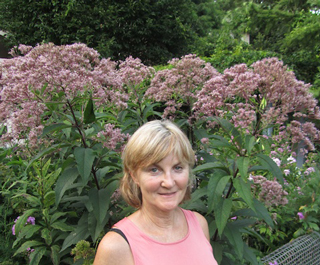
Joe Pye Weed (Eupatorium maculatum ‘Atropurpureum’)
stands tall in the July garden with Rose Cooper Bush
Louisville, Kentucky
Photo: Allen Bush
By Allen Bush
After two hours of weeding and planting in the sweltering morning heat, it’s usually time to throw in the towel. Well, not quite. I keep a towel handy to wipe the sweat off my creased brow and dab my receding hairline. This is one coping ritual for mid-summer. A cool swim later in the afternoon can work wonders, too. But the Lakeside temperature is hovering near 90 F (32 C). There’s no magic, there. When the morning temperature hits the low end at 80 F (27C), as the sun comes-up, you know you’re in for a rough ride the rest of the day. There’s no stopping 90 F (32 C) or hotter. During spells like this, when the humidity is as stifling as the debate on debt limits, it’s hard to catch a break.
July wasn’t hot straight the way through, and I wasn’t stuck in Kentucky all month, either. I caught a breather in the Colorado Rockies, with good friends, looking at alpine wildflowers in early July. My pals Kirk Alexander and Panayoti Keliaidis organized a great tour. I’d call home each day and Rose would tell me about the skyrocketing Louisville heat index that hovered in the triple digits for days. I tried to be sympathetic. The annoying heat index – a summer flogging by forecasters – combines ambient temperature with the relative humidity. But it doesn’t skewer “the hardware of reality.” It’s hot and we all know it.
I didn’t tell Rose I was wearing a cotton sweater at 10,000 on the road up to Pikes Peak. Nor did I dwell on walks through meadows in the alpine tundra filled with primroses and alpine forget-me-nots.
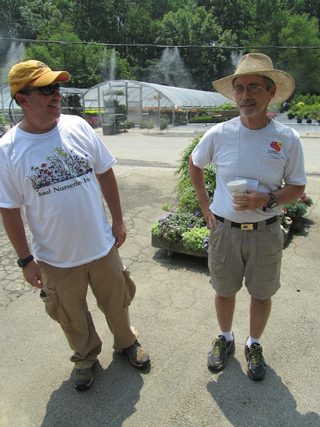 Nurserymen Richard Saul and Ozzie Johnson at the Saul Brothers’ Swamp location in Atlanta, July 2011
Nurserymen Richard Saul and Ozzie Johnson at the Saul Brothers’ Swamp location in Atlanta, July 2011
Photo: Allen Bush
At the end of the Perennial Plant Association symposium during the third week of July, I drove from Atlanta to Clermont, Georgia, to McMahan’s Nursery to visit my friend, the nurseryman and plant explorer Scott McMahan. It was plenty hot in Georgia, too. I seldom return from a trip without picking-up a few plants. I’d already broken the ice (I feel cooler mentioning ice….) a few days before at McMahan’s downtown Atlanta Garden*Hood and across town at the Saul Nurseries Swamp location.
When the temperatures rise above 90 F (32 C) normal retail garden center customers call it quits until the next spring. But the plant-obsessed keep on shopping and planting. At McMahan’s I kept piling-up my cart, and only at the verge of heat stroke pulled out the Visa card, double-stacked the plants in the car, turned on the air conditioning, and drove home on country roads through the mountains, bordered on either side by kudzu vines climbing-up trees along the forest’s edge.
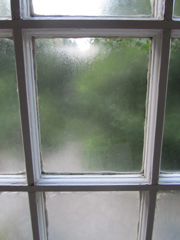 Thank God for A/C. Interior in Louisville, late July
Thank God for A/C. Interior in Louisville, late July
Photo: Allen Bush
By the time the kudzu canyons started to dwindle and there were no more handmade signs pointing the way to “Boiled peanuts just ahead,” I figured I must have crossed into Tennessee. When I pulled-in the drive way in Louisville at 9:00 that night, the evening air was suffocating. The house windows were fogged-up.
I worked in retail from 1980 to 1995. Eager garden center customers would come around in April and May ready to fulfill magazine-stoked garden notions. In the ‘80s, an English mixed perennial border was the fantasy. Billowy white baby’s breath and towering delphiniums in breathtaking colors looked so easy and effortless in the great English gardens. It took years before Americans could think of the native Joe Pye weed Eupatorium maculatum ‘Atropurpureum’ as majestic, a peer of the statuesque English Delphiniums. For years, it had to be English. Puny 18” (45 cm) Delphinium statuettes in the south didn’t cut it.
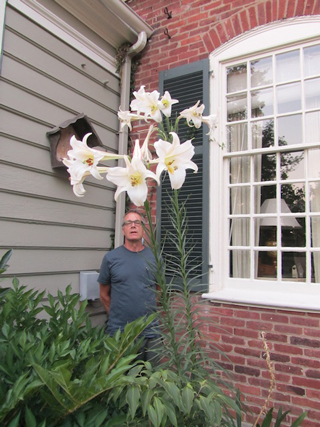 Allen Bush with Lilium formosanum, a wonder of July in the Tophill garden, Louisville
Allen Bush with Lilium formosanum, a wonder of July in the Tophill garden, Louisville
Photo: Rose Cooper Bush
I tried to be consoling. When southern delphiniums died before Independence Day, I urged all blame be fobbed-off on the bloody British. I can’t be without Joe Pye weed and the companion, easy-to-grow, eight-foot tall (244 cm) Formosa lily. Lilium formosanum is too good to believe. And it self-sows and often flowers the first year.
“How much time do you want to spend in your garden, “ I would ask retail customers. The answer was always an enthusiastic, “As much as possible!” The customer has a pulse. The follow-up question —and often the deal breaker—was: “How much time do you want to spend in the garden in July and August?” The answer, the hard truth: “As little as possible.”
I could have sold a lot more plants if I’d treated the exercise like selling used cars. “You can’t go wrong. Plant perennials once and you’ll never have to plant them again. They’re no fuss whatsoever.” Woe is the home gardener who dared to ask me for a personal guarantee: “Will your perennials live forever?” It was a waste of time to offer all the obvious reasons why drought and pestilence might strike their plants dead by the time they got home.
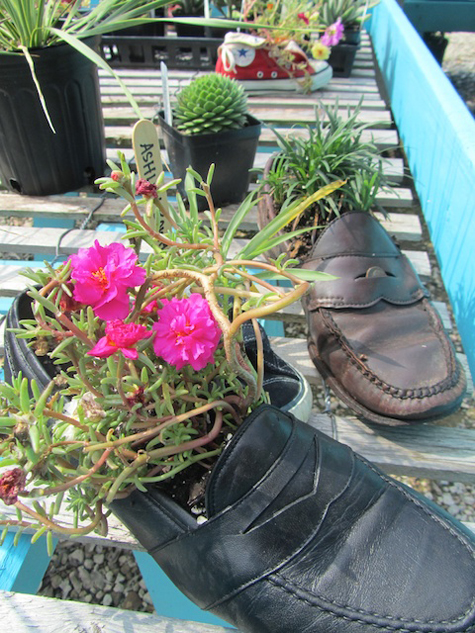
Soleful potting at Garden*Hood, in Atlanta
Photo: Allen Bush
I stumbled-on a fool proof answer; it came pouring out of my mouth in frustration one day: “They’ll live if it’s God’s will.” No sense equivocating on this point. Nobody ever came back to challenge me. Or maybe the plants lived happily ever after—as God, not I, ordained.
Steering back from Georgia last week, my wagon was packed to the gills, leaves of my new plants pressing-up against the windows. A few motorists gave me the thumbs-up; most just stared and wondered. I came home with twenty-two trees, shrubs and perennials to plant. McMahan and his sidekicks Ozzie Johnson and Dan Hinkley had discovered a few of them on trips to Sichuan and Northern Viet Nam.
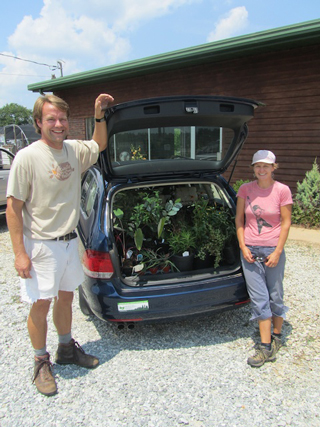 Scott McMahan and Tiffany Jones of McMahan’s Nursery, Claremont, Georgia, pack up the author for the trip back to Louisville.
Scott McMahan and Tiffany Jones of McMahan’s Nursery, Claremont, Georgia, pack up the author for the trip back to Louisville.
Photo: Allen Bush
I fell hard for Hydrangea aspera ‘Golden Needle’ that they collected near the town of Taoyuan. Even though Mike Dirr pays little attention to the species in Manual of Woody Landscape Plants, I have to think that it’s do-able in Kentucky if it withstands the Georgia summer heat. The lavender buds open-up to white mopheads. They found Lilium poilanei on another trip in the mountains of Northern Viet Nam, near the border with Yunnan. Scott said it had recurved, sweet-scented yellow blooms with red splotches on the insides of the trumpets. I grabbed a pot. (It’s the rainy season in the mountains of Sichuan and Northern Viet Nam. We could stand some rain, here, about now.)
Then there was Anisacanthus wrightii, the Texas firecracker – a perfect common name for my summer mood. I ignored the warning that it might be hardy to only Zone 7. Kentucky is zone 6 but hummingbirds love the plant and so it gets a shot. Same thing with the zone-challenged (zone 7) blue flowering Burmese plumbago, Ceratostigma griffithii. Blue flowers are as scarce in my garden as a cool day in July. The red tinted autumn foliage doesn’t sound too bad, either. I trust the Burmese plumbago, my little piece of the Himalayas, will be fine in Kentucky. God willing.
Comments
Thanks, Georgia. Glad you got some rain. We’re doing ok with a few lucky scattered showers, but Louisville had its third hottest July on record. August looks like more of the same. As they like to say in Georgia, “It’s so hot, even the bass have ticks.”
I have to admit, I have spent precious little time in my garden this last month. I keep getting distracted (and the mountains are so alluring, as you know!). Yesterday we left sweltering Denver (high: 96F): at the top of Mt. Evans, the frozen freshets were still topped with thick ice, and I feared the wind gusts at 40F would tip over my van. Felt good going back down tot he heat, I admit!


Sounds as hot as it was in NYC. We got rain two days in a row and hoping for more. Trees growing in concrete planters and in micro urban heat islands are stressed!
Lovely photo of Rose and the rosy-blossom Joe Pye Weed.